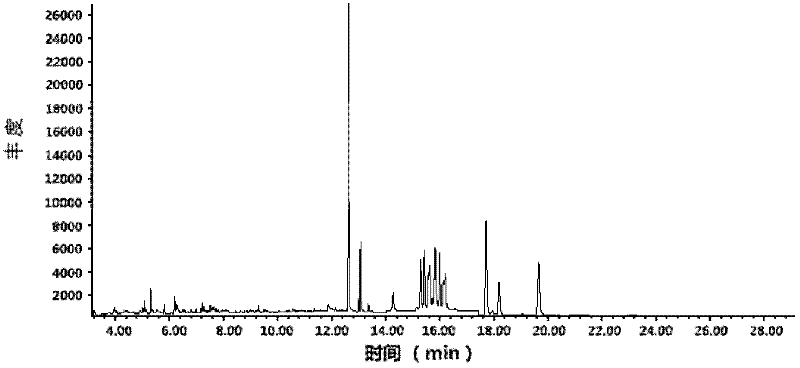Extraction method for residual pyrethroid pesticides in water environment
A pyrethroid, water environment technology, applied in measuring devices, instruments, scientific instruments, etc., can solve the problems of high price, poor selectivity, reduced detection sensitivity, etc., and achieve the effect of fast separation
- Summary
- Abstract
- Description
- Claims
- Application Information
AI Technical Summary
Problems solved by technology
Method used
Image
Examples
Embodiment 1
[0021] Use a density of 0.02mm as the density of 0.915 g / cm 3 A low-density polyethylene film was used to prepare an extraction film bag with an inner diameter of 4 mm and a length of 2 cm.
[0022] Soak the extraction film bag in a mixed solution of n-hexane and acetone with a volume ratio of 9:1 for 10 minutes to pretreat the film bag.
[0023] Take 15ml of water sample, add appropriate amount of sodium chloride until the solution is saturated, and place the saturated solution in a 20ml headspace sampling vial.
[0024] Fix the above-mentioned film bag in the headspace sample bottle, then add 0.2ml of n-hexane into the film bag, and seal it with a cap. Then the headspace vial was placed in a shaker and extracted at 25°C and 300rpm for 180min.
[0025] After the extraction, the extraction solvent was transferred to a 2.0ml sample injection vial and detected by GC-ECD. The detection results are shown in Table 1, and the chromatogram is shown in Table 1 figure 1 shown.
[0...
Embodiment 2
[0031] With a density of 0.03mm is 0.920 g / cm 3 A low-density polyethylene film was used to prepare an extraction film bag with an inner diameter of 5 mm and a length of 3 cm.
[0032] Soak the extraction film bag in a mixed solution of n-hexane and acetone with a volume ratio of 9:1 for 15 minutes to pretreat the film bag.
[0033] Take a 15ml water sample, add appropriate amount of sodium chloride to a saturated solution, and place it in a 20ml headspace sampling vial.
[0034] Fix the above membrane bag in the headspace sampling bottle, then add 0.4ml cyclohexane into the membrane bag, and seal the top hole sampling bottle with a cap.
[0035] The headspace sampling vial was placed in a shaker and extracted at 30°C and 450rpm for 120min.
[0036] After the extraction was finished, the extraction solvent was transferred to a 2.0ml sample injection vial and detected by GC-MS. The results are shown in Table 2 and figure 2 shown.
[0037] Table 2 GC-MS analysis results of ...
Embodiment 3
[0041] With a density of 0.04mm is 0.930 g / cm 3 A low-density polyethylene film was used to prepare an extraction film bag with an inner diameter of 6 mm and a length of 4 cm.
[0042] Soak the extraction film bag in a mixed solution of n-hexane and acetone with a volume ratio of 9:1 for 12 minutes to pretreat the film bag.
[0043] Take a 15ml water sample, add appropriate amount of sodium chloride to a saturated solution, and place it in a 20ml headspace sampling vial.
[0044] Fix the above-mentioned film bag into the headspace sampling bottle, then add 0.8ml of n-hexane into the film bag, and seal the headspace sample bottle with a cap.
[0045] The headspace vial was placed in a shaker and extracted at 45°C and 600rpm for 60min.
[0046] After the extraction is finished, the extraction solvent is transferred to a 2.0ml sample injection vial and detected by GC-MS. The inventive effect is similar to that of Example 2.
PUM
| Property | Measurement | Unit |
|---|---|---|
| thickness | aaaaa | aaaaa |
| density | aaaaa | aaaaa |
| length | aaaaa | aaaaa |
Abstract
Description
Claims
Application Information
 Login to View More
Login to View More - R&D
- Intellectual Property
- Life Sciences
- Materials
- Tech Scout
- Unparalleled Data Quality
- Higher Quality Content
- 60% Fewer Hallucinations
Browse by: Latest US Patents, China's latest patents, Technical Efficacy Thesaurus, Application Domain, Technology Topic, Popular Technical Reports.
© 2025 PatSnap. All rights reserved.Legal|Privacy policy|Modern Slavery Act Transparency Statement|Sitemap|About US| Contact US: help@patsnap.com



